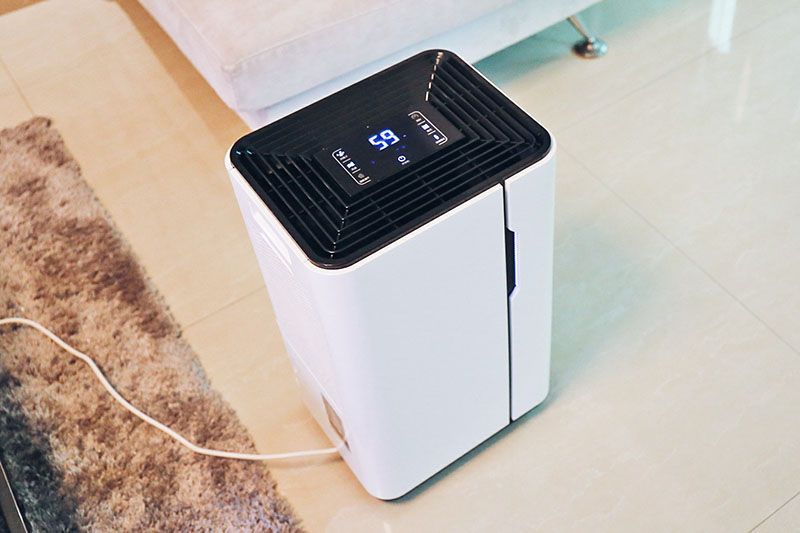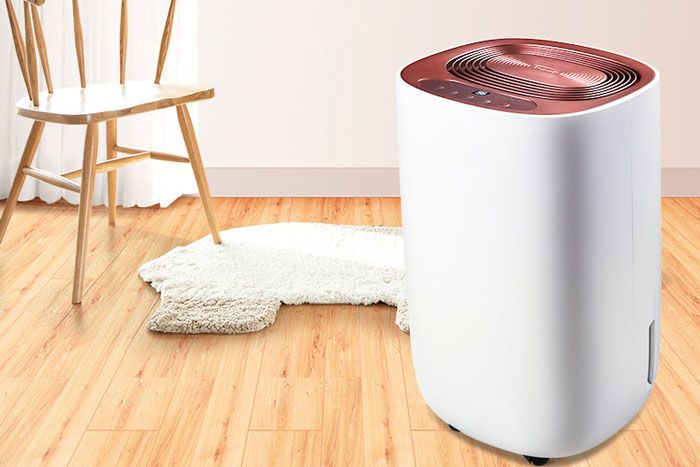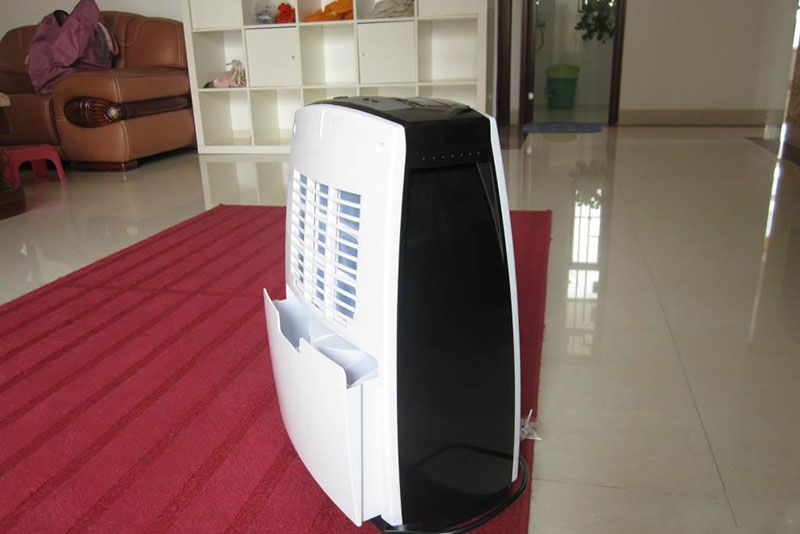- Home >> Solution >> Appliances >> home appliances
Dehumidifier solution
Dehumidifiers, also known as dehumidifiers, dryers, and dehumidifiers, can generally be divided into two categories: household dehumidifiers and industrial dehumidifiers, and belong to a small member of the refrigeration and air-conditioning family. The working principle of the compressor is basically the same as that of the air conditioner compressor. "The mainstream product of the dehumidifier compressor is the rotary compressor. Compared with the air conditioner, the basic structure and principle are similar. Only the cooling capacity is smaller and the volume is smaller. At the same time, the requirements for miniaturization are higher.
1. The working principle of the dehumidifier solution
The fan of the dehumidifier draws the humid air into the machine, and passes through the heat exchanger. At this time, the moisture in the air condenses into water droplets, becomes dry air and is discharged outside the machine. This cycle reduces the indoor humidity. After the treated air is inhaled by the fan, it is first filtered by the air filter, and then cooled and dehumidified on the cooled evaporator, and the excess water vapor in the air is condensed into water to reduce the moisture content of the air. As the dehumidified condensed water takes away part of the heat and humidity, the temperature of the air decreases accordingly, making the air temperature and humidity suitable.
The dehumidifier is composed of a compressor, heat exchanger, fan, water tank, casing and controller. Its working principle is: the fan draws humid air into the machine and passes through the heat exchanger. At this time, the moisture in the air condenses. It turns into water droplets, turns into dry air and is discharged outside the machine. This cycle reduces the indoor humidity. The internal circulation of the dehumidifier: through the operation of the compressor → discharge high-temperature and high-pressure gas from the exhaust port → enter the condenser for cooling → become low-temperature and high-pressure gas → intercept flow through capillary tubes → become low-temperature and low-pressure liquid → evaporate and absorb heat through the evaporator → Return to the compressor to become a low-temperature and low-pressure gas. And so on and on. The external circulation of the dehumidifier: In the case of normal startup → through the operation of the fan → the humid air is sucked from the air inlet → passes through the evaporator → the evaporator absorbs the moisture in the air on the aluminum sheet → becomes dry air → undergoes condensation Radiator heat dissipation → blow out from the air outlet.

2. Classification of dehumidifiers
1. Cooling dehumidifier
As the name suggests, this dehumidifier basically relies on the principle of refrigerant cooling for dehumidification. It is specifically divided into three categories: general dehumidifiers, cooling dehumidifiers, and multi-functional dehumidifiers.
(1) Ordinary dehumidifier means that the air is cooled and dehumidified by the evaporator, heated by the reheater, and the relative humidity is reduced. The condensation heat of the refrigerant is all taken away by the air flowing through the reheater, and the outlet air temperature cannot be adjusted. , only for dehumidifiers that heat up and dehumidify.
(2) The cooling type dehumidifier refers to the general type dehumidifier. Most of the condensation heat of the refrigerant is taken away by the water-cooled or air-cooled condenser, and only a small part of the condensation heat is used to heat the air after passing through the evaporator. Dehumidifiers that can be used for cooling and dehumidification. The temperature-adjusting dehumidifier refers to the general dehumidifier. The heat of condensation of the refrigerant can be taken away by water-cooled or air-cooled condensers in whole or in part, and the remaining heat of condensation is used for heating. The air after the evaporator, the dehumidifier whose outlet temperature can be adjusted.
(3) Multifunctional dehumidifier refers to a dehumidifier that integrates three functions of heating and dehumidification (general type), cooling and dehumidification, and temperature adjustment and dehumidification. It can still be used when there is no outdoor unit (air cooling) or cooling water (water cooling). Choose a dehumidifier with a heating and dehumidification function for dehumidification.
2. Rotary dehumidifier
The main structure of the rotary dehumidifier is a constantly rotating honeycomb drying wheel. The drying wheel is the key component for absorbing moisture in the dehumidifier. It is composed of corrugated media made of special composite heat-resistant materials. The corrugated media is loaded with hygroscopic agents. This design has a compact structure and can provide a large surface area for full contact between the humid air and the hygroscopic medium. Thereby greatly improving the dehumidification efficiency of the dehumidifier.
3. Solution dehumidifier
The solution dehumidification air-conditioning system is a new type of air-conditioning product that can provide fresh air operating conditions developed based on the active dehumidification air treatment technology that uses dehumidification solution as a hygroscopic agent to adjust air humidity and water as a refrigerant to adjust air temperature; its core is to use dehumidification Based on the physical characteristics of the agent, through an innovative solution dehumidification and regeneration method, efficient dehumidification above the dew point temperature is achieved. The temperature and humidity adjustment of the system is completely carried out in an open atmosphere at normal pressure, which has the technical characteristics of simple manufacture, reliable operation, energy saving and high efficiency. The system mainly consists of four basic modules. They are air supply (fresh air and return air) module, humidity regulation module, temperature regulation module and solution regenerator module.
4. Pipeline dehumidifier (suction)
The pipeline dehumidifier uses an evaporator to cool and dehumidify the air, and recovers the condensation heat of the system to make up for the heat lost in the air due to cooling and dehumidification. It is an efficient and energy-saving dehumidification method. A pipe-type temperature and humidity regulation method and its equipment for heating, cooling and dehumidifying indoors at low temperature to meet indoor temperature and humidity requirements. The pipe dehumidification system mainly consists of a cooling dehumidification mode, a temperature regulating dehumidification mode, a heating dehumidification mode, and a heating mode. , composed of automatic defrosting.

3. Performance comparison of various dehumidifier solutions
1. Cooling dehumidifier solution
Advantages of cooling dehumidifier: good dehumidification effect, fast drop in room relative humidity, low operating cost, no need for heat source, and no need for cooling water, low energy consumption, simple operation, easy to control, and has been widely used in national defense projects , civil air defense projects, various warehouses, libraries, archives, underground engineering, electronics industry, precision machining, medicine, food, agricultural seed storage and various industrial and mining enterprise workshops and other places.
Disadvantages of cooling dehumidifiers: In places with relatively high humidity requirements, it is obviously uneconomical to use refrigerated dehumidifiers, and the noise is relatively large.
2. Rotary dehumidifier solution
Advantages: The rotary dehumidifier does not need cold coal, so there is no compressor, and it is about half the weight of a traditional dehumidifier. Because there is no compressor, it is quieter during operation, but compared with the current refrigeration dehumidifiers, it is not necessarily quieter in the normal mode, but the silent mode is really very quiet, so quiet that you can hardly feel it.
Disadvantages: Renewable energy consumption is large and expensive.
3. Solution dehumidifier solution
Advantages of the solution dehumidifier: When the small multi-functional solution dehumidifier introduces fresh air, it first exchanges heat with the indoor return air before the fresh air enters the refrigeration dehumidification core, so that most of the energy in the room can be recovered and reduce the intake of the refrigeration dehumidification core. The enthalpy value of the fresh air can reduce the heat load of the compressor, greatly improve the efficiency of the compressor, and save energy. It organically combines innovative liquid dehumidification technology with mature heat pump technology, miniaturizes the unit, and creates a brand-new high-efficiency air-conditioning dehumidification system that can be widely used. advantages of convenience and efficiency.
Disadvantages: low moisture permeability for solution dehumidification, poor strength, high cost, and additional cold source and heat source are required, and the structure is relatively complicated.
4. Pipeline dehumidifier solution
Advantages of pipeline dehumidifier: the compressor adopts a fully enclosed flexible scroll type; through the scientific and reasonable optimization design of the refrigeration system, the heat exchanger has a compact structure, good pressure resistance, high heat exchange efficiency, low noise, reliable operation, and high energy efficiency ratio. .
The disadvantage is that the maintenance cost is high, and it is more suitable for use in large areas.

4.The defrosting principle of the dehumidifier
When the compressor dehumidifier is used in a relatively low temperature environment (generally below 10 degrees Celsius), it will cause frost on the heat exchange system of the dehumidifier. When it is low, it will enter the defrosting state periodically. At this time, the dehumidifier will first stop the compressor, and use the evaporator heating wire (a part of the heat exchange system) to heat the temperature of the heat exchange plate, and then output it through the fan to produce a defrosting effect.
This time-consuming needs to be determined by the ambient temperature. The lower the ambient temperature, the longer the time-consuming. During the defrosting process, the compressor-type dehumidifier cannot perform dehumidification work. The effect is not ideal. If it is a dehumidification environment with low ambient temperature, you can buy a new type of rotary dehumidifier.
5. Application advantages of the dehumidifier solution
A dehumidifier removes moisture and dries out the air. Widely used in computer rooms (medicine, electricity, telecommunications), workshop warehouses (electronics, footwear, clothing, tobacco, food, leather, glass, paper), file management (banks, public security, museums, archives, government agencies), etc. Environments, families, etc. where the above-mentioned space area is small. The following are the application advantages of the two types of dehumidifiers.
1. Household dehumidifier solution
The household dehumidifier is developed for the humid environment, which can not only effectively improve the humid living and production environment, make it ideal, but also remove the mold caused by the humid environment. The dehumidifier can remove the moist moisture and suspended particles through operation, making the air dry. It is also an air purifier. Among them, the household dehumidifier is used in all aspects of production and life to create a comfortable, dry and quiet modern life for users. space.
The scientific research report of household dehumidifiers pointed out that the human body has high requirements for the humidity of the living environment. The relative humidity should be 55-65%, preferably not less than 50% in winter, and not more than 80% in summer. If the humidity is too high, it is easy to cause: clothes and leather are damp and moldy; food, medicine and tobacco are deteriorated; electrical appliances and precision instruments are damaged by moisture; Diseases and rheumatism; in summer, it is difficult for the human body to dissipate heat, which increases the chance of heat stroke; in winter, heat conduction is accelerated, making people feel colder. It can be seen that reducing humidity is not only concerned by the storage department, but also needed by ordinary people living at home. At present, the main production areas of household dehumidifiers in the world are concentrated in Australia, Italy, Japan and Taiwan.
2. Industrial dehumidifier solution
Industrial dehumidifiers are very professional electromechanical equipment, and people don't know enough about them. When choosing a dehumidifier, they often simply select the type according to the area of the dehumidified place. Industrial workshops, warehouses, etc. are air purification equipment with technological requirements, and their target humidity has strict requirements.
Therefore, dehumidification equipment such as industrial dehumidifiers cannot be selected simply based on the area of the place of use. Professional industrial dehumidifier suppliers select the type according to the overall humidity load of the place of use. Specifically, it calculates key parameters such as total cooling capacity and dehumidification per unit time based on comprehensive factors such as its area, floor height, initial humidity value, target humidity value, indoor airtightness, dehumidification source, and fresh air supply. selection.

6. Use and maintenance of dehumidifier
After the installation is complete, you can start using it. Before the dehumidifier is running, you should first close the doors and windows to prevent humid air from entering the room and affecting the dehumidification effect. It is the same as reducing the number of door openings and closings of the refrigerator. After using a household dehumidifier for a period of time, the air intake filter will accumulate dust. If the dust accumulates too densely and thickly, it will affect the dehumidification effect. The humidity sensor of the machine is generally placed on the On the ventilated surface, if the use environment is not good and the humidity sensor is blocked by dust, the sensor will not be able to display and control the humidity. You can use a soft brush to remove the dust on the sensor and keep the sensor clean. After using for a period of time, the user should stop the machine at least once a week to do some general maintenance, such as whether the machine filter needs to be cleaned, whether the machine has abnormal noise, etc. It is best to do a regular inspection every six months to a year to make the front and rear ventilation Smooth, pour out the accumulated water in the water tank in time to avoid the breeding of bacteria.
When not in use for a long time, unplug the power plug and clean the whole machine. Volatile oil, thinner, and detergent may cause damage to the machine. Do not use it; pour out all the water in the water collection tank, remove the dust from the filter, and put it A place that is not exposed to sunlight and is well ventilated. In addition, never put the dehumidifier on its side or upside down during storage, so as not to damage the compressor. Most dehumidifiers are controlled by digital microcomputers. reduce its service life.
The above are the details of the dehumidifier solution introduced by Shenzhen Zuchuang Microelectronics Co., Ltd. for you. If you have functional development needs for dehumidifiers, dehumidifiers, dehumidifiers, dehumidifier principles, air dehumidifiers, and household dehumidifiers, you can trust us. We have rich experience in customized development of electronic products and can evaluate and develop them as soon as possible. Cycle time and material price.
- TOP
